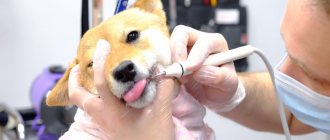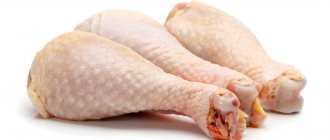Do cats have tooth decay?
Cats have such a dental structure that caries is a rare problem for them, but poor environment and poor quality nutrition make cats increasingly suffer from caries.
Kittens do not have problems with teeth. Everyone knows that cats do not eat sweets. But, unfortunately, caries still occurs in adult cats. This disease does not appear overnight; it develops over a long period of time, destroys the enamel and is rotting of the bone tissue of the tooth.
Symptoms of toothache in cats
Since there are many causes of dental disease in cats, it is advisable for the owner to closely monitor his pet in order to notice the problem at the initial stage of its development. The most common signs of dental disease in cats are:
- red, sore, or swollen gums;
- the presence of an abscess or lump on the animal’s jaw;
- pungent and unpleasant odor from the mouth;
- loose or worn down teeth;
- increased salivation.
Attention! It is important to remember that the symptoms of dental diseases usually appear gradually, so attentive owners always have a chance to notice the pathology in time and begin treatment, preventing the development of the disease.
At the same time, the animal’s reaction to toothache is practically no different from the human reaction:
- It becomes painful for the animal to chew, especially in the area of the affected tooth. If the pain is very severe, the cat may refuse to eat altogether. You can easily notice that she is trying to chew so as not to touch the sore tooth.
- The cat's behavior changes: it becomes irritated, aggressive, and is capable of scratching or biting its owner, especially when trying to pick it up and examine its mouth.
- The animal constantly rubs its face with its paw, washes itself or persistently rubs its cheek on hard surfaces, meows, and behaves restlessly.
Causes and symptoms of toothache
Signs, symptoms
Veterinarians recommend performing oral exams on your pets at least once a week. Animals may have injured mucous membranes, threads may become tangled in their teeth, or carious lesions, so you need to brush your pet’s teeth twice a week to avoid troubles in the animal’s oral cavity.
Signs of caries are:
- Darkening of the enamel of the diseased tooth;
- Bad breath;
- Profuse salivation
- Changes in the animal's behavior while eating. For example, the cat will begin to chew food on only one side, or will try to swallow immediately without chewing.
- Pain while chewing;
- Loss or decreased appetite.
The pet will not be able to complain to the owner about the pain; he usually begins to avoid touching the diseased tooth.
When a cat suffers from tooth pain, its behavior changes dramatically. Many begin to behave aggressively.
During a toothache, a pet may scratch its face with its paw, meow pitifully, or sit motionless for a very long time and keep its mouth open.
With regular examinations, the cat owner will be able to detect the appearance of caries in the early stages.
You should pay attention to redness and swelling of the gums, the appearance of dark spots on the teeth and an unpleasant, putrid odor from the mouth.
Reference!
As soon as at least one of the listed signs is noticed, the pet must be immediately shown to a veterinarian. There is no need to brush your cat's teeth with human toothpaste against caries; this procedure will not bring any effect.
How dangerous is the disease?
Even though this is a gum disease, the consequences for cats can be dire. For example:
- Periodontal disease in cats leads to tooth loss. Not only is this not aesthetically pleasing (after all, a cat with beautiful teeth in full is more beautiful, isn’t it?), it also makes the cat’s life much more difficult, since it becomes impossible for him to chew food.
Reference! With the development of periodontal disease, even if they have teeth, cats do not chew food, but try to swallow it whole. This is due to severe pain in the cat, which he tries to avoid in this way.
- With periodontal disease, active reproduction of various pathogenic microorganisms occurs in the oral cavity, the waste products of which are toxic to the cat’s body. This affects the general condition of the fluffy’s body.
- If the cat is old, pregnant, or has a weakened immune system for any other reason, periodontitis can lead to such a serious complication as sepsis, which can lead to the death of the animal.
Reference!
Sepsis is a severe generalized condition of the body that occurs when an infectious agent enters the blood of an animal. The literal translation from Latin is putrid blood.
It is within the power of the owners to prevent the development of complications. To do this, it is enough to take the cat to a veterinary doctor on time and strictly follow his recommendations, even if this will not be very pleasant for the pet.
Causes
There are some known reasons why such an unpleasant disease occurs in the cat breed:
- Insufficient amounts of macroelements and minerals in the animal’s diet;
- Lack or absence of iodine, phosphorus and fluorine in the body;
- Lack or deficiency of vitamin B;
- Eating bones and roughage leads to mechanical injuries, which can cause caries in cats.
- Tartar, which appears in the form of plaque, eventually leads to caries.
- Metabolic disorders and weak immunity are favorable conditions for problems with tooth enamel;
Causes of caries
Doctors have not yet fully figured out what causes tooth decay in cats. However, there are several versions of the occurrence of this disease:
- Lack of B vitamins. As a rule, it is the vitamins of this group that are responsible for the health of teeth, coat and claws in cats;
- Various types of damage to the gums, as a result of which infection occurs and tissue death begins;
- Metabolic disorders;
- Lack of certain minerals and beneficial trace elements - zinc, iodine, iron, etc.;
- Damage to tooth enamel;
- Presence of tartar (appears due to insufficient oral care and improper feeding).
Whatever the reason, if any of the primary symptoms of caries are detected, you should immediately consult a doctor to find out the details.
Varieties
Caries is divided into several groups:
- The first stage, when the disease is expressed by darkening of the tooth enamel, is called spotted caries.
- Superficial caries. Black indentations appear on the enamel.
- Average type of caries. This type affects the dentin structure in addition to the enamel.
- Deep caries. The damage reaches the pulp.
To protect your pet from an unpleasant illness, choose the right food for your cat, which will be rich in all the necessary vitamins and substances. Those cats whose genetics are prone to plaque should be fed with special veterinary food.
Treatment: what to do?
What to do if your pet has caries?
He definitely needs to be treated! First of all, you need to contact a knowledgeable specialist who will conduct a professional examination of the cat’s oral cavity. It is not recommended to treat your cat yourself at home. Only veterinarians should fix dental problems.
When the disease is detected at the very beginning, the specialist will prescribe medications to the cat that contain sodium fluoride and silver nitrate. If the caries lesion is deep, then tooth extraction will be required.
There are situations when it is not possible to get an appointment with a veterinarian, in which case make a chamomile decoction and rinse the animal’s mouth with it as often as possible. If there is tartar, you can scrub it off with a piece of gauze soaked in a weak solution of hydrogen peroxide, or with a toothbrush with soft bristles.
Important!
All actions that are performed at home will not bring effective treatment. Remember that every day of delay will lead to more destruction of the enamel!
Causes of periodontal disease
One animal may have several reasons for its dental problems.
Lack of oral hygiene
Simply put, the cat does not brush its teeth. Over the course of life, teeth become increasingly covered with soft plaque. Plaque is 80% a bacterial colony. The remaining 20% is the epithelium of the oral cavity, saliva, and food particles. When saturated with calcium salts, plaque turns into tartar - a hard brown mass that cannot be removed with any brush.
The waste products of bacteria trigger a strong inflammatory process in the gums (gingivitis). The gums gradually “dissolve”, move away, and pockets and subgingival tartar form. Periodontal pockets are already a sign of destruction of the jaw bone around the tooth.
The older the cat, the greater the likelihood of developing periodontitis.
Infectious diseases
Inflammation of the gums and mucous membranes of the oral cavity (gingivostomatitis) is sometimes caused by viral diseases of cats:
- immunodeficiency (FIV) and leukemia (FeLV);
- calicivirus;
- rhinotracheitis (herpes virus).
If left untreated, gingivitis gradually progresses to periodontitis.
Non-communicable systemic diseases
- Diabetes. Diabetes inhibits the healing of any tissue, including those destroyed by infection. Decreased immunity in diabetic cats provokes increased proliferation of bacteria in the oral cavity.
- Kidney failure. Toxic products of protein metabolism are not excreted by the kidneys and begin to be released in the form of ammonia through the mucous membranes, corroding them. In older cats, you can see not only severe inflammation of the gums, but also ulcers on the tongue and cheeks.
- Irregularity of teeth. It is found in certain breeds - Persians, Exotics, British. Flat-faced (brachiocephalic) cats have a jaw that is too short to accommodate the natural number of teeth. As a result, the teeth are crowded, crooked and at random. They cannot be cleaned naturally and quickly become overgrown with tartar. Teeth can grow unnaturally for other reasons: jaw fracture, malocclusion (overshot, undershot).
- Genetic predisposition. Some cats can live 15-20 years without serious dental problems. In others, massive tartar and loss of molars are observed as early as 8-12 years of age. When this cannot be attributed to other factors, it is obvious: dental and oral health can be inherited.
Improper feeding
Eating only soft foods does not put stress on the teeth when chewing. In animals, teeth must work, this strengthens the ligament of the tooth and gum tissue. Wet canned food or cereal accumulates on teeth, accelerating the development of tartar. Soft food does not clean teeth mechanically, as happens when chewing cartilage or dry food granules. The composition of the feed itself is also important.
A complete dental examination, including x-rays of the jaws, is carried out only under general anesthesia. In this regard, doctors prescribe examinations not only to find out and eliminate the cause of periodontal disease, but also to assess the risk of anesthesia for the patient.
At the initial appointment
- Detailed clinical and biochemical blood test (after a 10-12-hour fasting diet).
- Oral rinsing for rhinotracheitis and calicivirosis.
- Blood test for immunodeficiency virus and leukemia.
Before giving anesthesia
- Ultrasound examination of the heart (ECHO-cardiogram).
- If necessary, other studies in which the anesthesiologist sees a need: x-ray of the lungs, blood clotting test.
Examination under sedation
The dentist examines the entire oral cavity. First, dental plaque is removed with an ultrasonic scaler. After this, using a thin probe, the depth of the pockets around each tooth is determined, and the degree of recession (exposure of roots) or gum growth is assessed. Ulcers are noted on the oral mucosa (most often these are areas in contact with massive tartar). If neoplasms are noticed, a piece of tissue should be taken for analysis.
It is necessary to conduct intraoral radiography, which allows you to clearly see the condition of the roots of the teeth and the degree of destruction of the jaw bone. X-rays can detect jaw tumors or abscesses.
After diagnosis, the doctor draws up a treatment plan. Often, examination, photographs and therapeutic procedures can be done under one anesthesia.
Sanitation of the oral cavity
Teeth cleaning
Treatment of periodontitis is impossible without thorough removal of tartar above and below the gum. Use a scaler with suitable tips. The oral cavity is washed generously with chlorhexidine.
Tooth extraction
After the teeth are freed from stone, those that cannot be saved are removed. In doubtful cases, rely on X-ray data.
It happens that to cure a cat it is necessary to remove all the molars, except for the fangs (occasionally, including the fangs). It is very important to remove the teeth by the roots, otherwise the inflammation will not be overcome. X-rays help detect the roots of long-lost teeth, where there is no visible crown, covered with inflamed gums.
After total extraction of teeth, an x-ray is taken again, the gums are cleaned and sutured with absorbable material.
Teeth polishing
If the doctor decides to save some of the teeth, then after thoroughly cleaning the surface, they must be polished. This makes it harder for soft plaque to stick, slowing down the re-formation of tartar.
Drug treatment
After sanitation of the oral cavity, a short course of painkillers and anti-inflammatory drugs (Loxicom suspension, tablets or ketofen injections) is prescribed.
Antibacterial agents are used to fight infection. Local medications are very difficult to use at home; it is a lot of stress for the cat and its owners. Sometimes doctors prescribe irrigation of the gums with an antiseptic (Miramistin, chlorhexidine, Iodinol) and local gels (Cholisal, Metrogil-denta).
A broad-spectrum systemic antibiotic is more often used if the process is advanced. The first choice drugs are amoxiclav in combination with clavulonic acid (Sinulox) and a special antibiotic for the oral cavity - Stomorgyl.
The cat is fed soft food for several days after surgery. Then, even with total tooth extraction, the pet will be able to eat dry food. If only part of the teeth have been removed, it is necessary to maintain oral hygiene at home in the future.
It is general anesthesia and the prospect of removing a large number of teeth that sometimes frighten the owner. Such treatment, if the information is presented incorrectly, looks repulsive. Sometimes an unqualified specialist himself does not undertake the operation, hiding behind the fact that “the cat is old and will not tolerate anesthesia” and other excuses.
It is important to understand that it is impossible to cure periodontal disease without proper cleaning of the oral cavity. You can smear bleeding gums with Metrogyl over tartar for years, take one course of antibiotics after another, and in desperation decide to take a course of prednisolone. Only this is not a treatment, but its appearance, to calm one’s own conscience. Without removing tartar, and more often the teeth themselves, all these actions are meaningless and even harmful: they exhaust the patience and wallet of the owner, and cause stress to the animal.
Prevention
Preventing any disease is much easier than treating it later.
Therefore, every owner should closely monitor the health of their pet. Your cat needs to brush its teeth regularly with a special toothpaste and brush.
A cat's diet should be correct, balanced and varied. It is imperative to add vitamins in tablet form to your cats’ food.
Feed your pet only solid food and solid store-bought food, and offer him plenty of bones and cartilage. This diet will help avoid unpleasant dental disease in your animal.
Important!
Veterinarians recommend regularly taking your cat for examination by specialists so that possible signs of the disease are identified as early as possible. Particular attention should be paid to this in cases where, during an independent examination, any changes in the cat’s oral cavity were noticed.
Treatment
Therapy at different stages of the disease differs significantly.
In mild (1 and 2) stages, when the periodontium is not yet affected by the pathological process, doctors most often make do with conservative treatment. Its main stages:
- Teeth cleaning. A veterinary doctor removes tartar and plaque from the enamel using surgical instruments or ultrasound.
- Teeth polishing (optional). The owner may be asked to polish the cat's tooth enamel. This is done in order to prevent the proliferation of bacteria (on the smooth polished surface of the teeth there is no place for microorganisms to attach, so they do not have the opportunity to reproduce).
- Coating of teeth with a special varnish containing fluoride. This event is carried out to strengthen the cat’s teeth.
- The gums are treated with an antiseptic to destroy pathological bacteria.
- To relieve inflammation, the doctor may prescribe antibacterial drugs (metronidazole, ABs of the cephalosporin group and others) and veterinary drops for lubricating the gums (“Zubastic”).
There are situations when even in the early stages there is a need to resort to surgical intervention, but this happens extremely rarely in some special cases.
Important!
You should not remove tartar yourself, as you can damage your gums and teeth, as well as the mucous membranes of your mouth. At the veterinary clinic, specialists will do everything carefully, in sterile conditions and, if necessary, put the animal under anesthesia to make it easier for him to endure the procedure.
Unfortunately, advanced cases (stages 3 and 4) have to be treated surgically. Veterinary dentists perform the following operations:
- Removing gum atrophy and strengthening teeth in sockets. It is important to completely clean the roots of the affected teeth.
- If preservation is impossible, the teeth are removed.
IMPORTANT. After surgery, you should definitely take antibacterial drugs prescribed by your doctor!











